Economics of Virginia
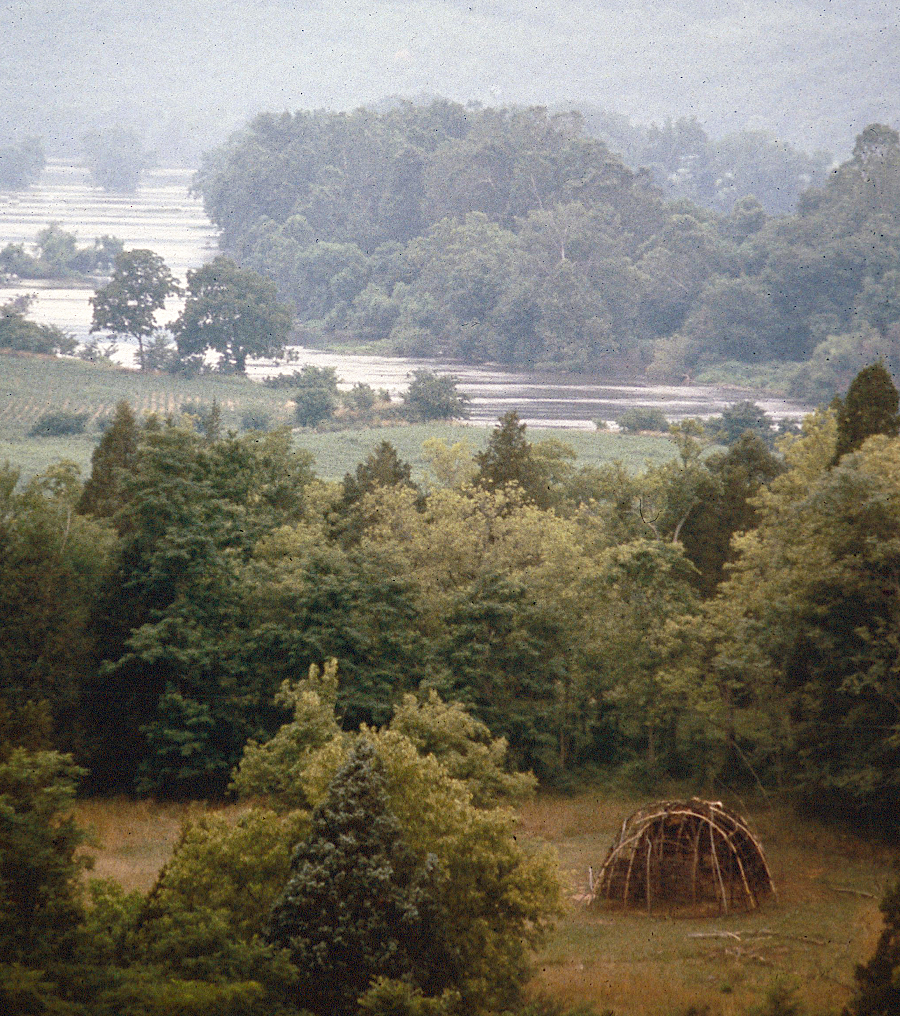
the first known house construction and industrial site in Virginia is over 10,000 years old, at the Thunderbird quarry in modern Warren County
Source: Virginia Department of Historic Resources, 093-0165 Flint Run Archaeological District (Thunderbird Archaeological District)
The first industrial operations in Virginia were quarries where jasper and flint were excavated over 11,000 years ago, and nearby camps where the high-quality was processed into spearpoints, knives, and other tools needed by Paleo-Indians. The oldest identified industrial factory and house construction site in Virginia is at the Flint Run Archaeological District (Thunderbird Archaeological District), located on the floodplain of the South Branch of the Shenandoah River six miles south of Front Royal.
Paleo-Indians, Virginia's first geologists, started to use the site regularly because it was the source of stone most suitable for fracturing and knapping to manufacture tools. The bow and arrow had not been invented 11,000 years ago, but later during the Woodland Period the "points" made at Thunderbird included arrowheads.1
The oldest industrial operation established by European colonists in Virginia is the glass production factory at Jamestown.
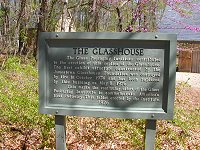
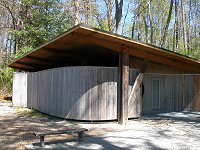
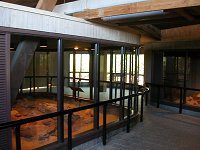
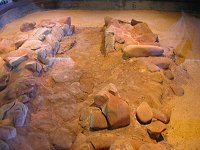

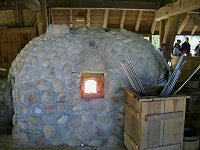
earliest Virginia site for manufacturing glass (1608 and 1621-22) and "reconstructed" furnace at Jamestown
(click on images for larger versions)
Businesses do not locate their facilities at random. In modern times, state, county, and city governments are active players in attracting private sector businesses and non-government organizations to locate in a particular area. They highlight the availability of raw materials, such as timber for lumber mills. The current economy prioritizes the skills mix of the labor force, so economic development recruiters now emphasize educational attainment by local workers.
The primary state agency recruiting employers to locate in Virginia is the Virginia Economic Development Partnership (VEDP), created in 1995. In 2017, the Joint Legislative Audit and Review Commission (JLARC) criticized the agency harshly. It noted in the evaluation that the Virginia Economic Development Partnership was not systematically planning, controlling, or evaluating its marketing activities, and its unstructured approach to administering incentive grants made Virginia vulnerable to fraud and poor use of limited resources.2
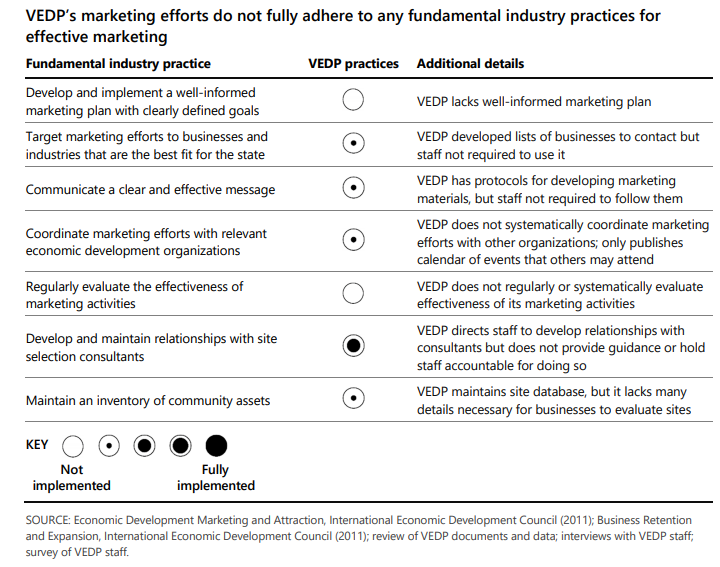
in 2016, the Joint Legislative Audit and Review Commission identified fundamental management weaknesses in the Virginia Economic Development Partnership (VEDP)
Source: Joint Legislative Audit and Review Commission (JLARC), Management and Accountability of the
Virginia Economic Development Partnership (p.ii)
Three years later in 2019, the Virginia Economic Development Partnership had new leadership and a different reputation. Site Selection magazine placed it #1 nationwide the magazine's annual Prosperity Cup ranking of state-level agencies dedicated to business recruitment and retention. The award reflected Virginia's success in recruiting a portion of Amazon's second headquarters, plus a commitment by Micron to invest $3 billion to expand a plant in Manassas that manufactured chip for automated cars.
As the Bacon's Rebellion blog noted, the award also reflected a fundamental ship in Virginia's efforts to recruit employers. It praised Stephen Moret, president and Chief Executive Officer of the Virginia Economic Development Partnership:3
- In the past, economic development professionals in Virginia were reluctant to stray far from their role as glorified practitioners of the real estate industry: developing, marketing, and selling large commercial and industrial sites. Moret understands and fosters linkages between economic development, job training, higher-ed, innovation ecosystems, and urbanism...
- ...Moret takes an integrative approach to economic development. The ability to think beyond traditional economic development tools such as tax breaks and subsidies was critical to clinching the Amazon deal. True, Virginia did offer significant incentives, but they were far less lavish than the packages offered by other states. Moreover, much of the state's commitment to the project consists of investments in higher education - a pledge to build human capital- and transportation infrastructure, both of which benefit Virginians broadly, not just Amazon.
Tax dollars are also used to retain jobs and property taxes, when other governments try to entice existing companies in Virginia to move to another location. For example, Virginia's A.L. Philpott Manufacturing Extension Partnership (VPMEP) was described in a news release:4
- The partnership, based in Martinsville and named after the late House Speaker A.L. Philpott of Bassett, works to improve the manufacturing capabilities and global competitiveness of manufacturers through offices in Danville, Harrisonburg, Lynchburg, Newport News, Norfolk, Richmond, Roanoke, Winchester and Wytheville. Internal VPMEP resources are supplemented by private consultants, community colleges, universities, and government agencies. VPMEP partners with Virginia's Center for Innovative Technology to provide access to high technology resources across the Commonwealth.
- In addition, VPMEP works in partnership with the Technology Applications Center (TAC) at Old Dominion University and the Manufacturing Technology Center (MTC) in Wytheville to bring services to manufacturers from Hampton Roads to Southwest Virginia:
- The Manufacturing Technology Center in southwestern Virginia is a consortium of five community colleges and is funded by VPMEP, the Commonwealth, CIT, and federal grants. It provides technology deployment and manufacturing modernization services in southwestern Virginia.
- The Technology Applications Center at Old Dominion University is funded by VPMEP and CIT. It primarily provides faculty-based engineering services to manufacturers for high technology product and process prototype development and testing in the Hampton Roads area and across Virginia.
VPMEP is based in Martinsville in part because A. L. Philpott was the powerful Speaker of the House of Delegates and he represented Pittsylvania County. Even before passage of the North American Free Trade Act (NAFTA), the textile, furniture, and other manufacturing businesses were reducing work hours and closing plants. The state and the local governments recruit companies that could provide high-wage manufacturing jobs to replace the companies that are leaving are reducing hours.
The Certified Business Location program, begun in the latter half of the 1980s, required each locality to establish an Industrial Development Authority, formalize their industry targeting activities, and establish other processes in support of industrial development. However, the Virginia Department of Economic Development no longer offers the certification.
In 2018, Congress revised the tax laws. It allowed investors to minimize taxes by reinvesting in 212 census tracts designated as Qualified Opportunity Zones by the US Department of Treasury. Governor Northam chose those zones from the 901 census tracts that were eligible, due to low-income.5
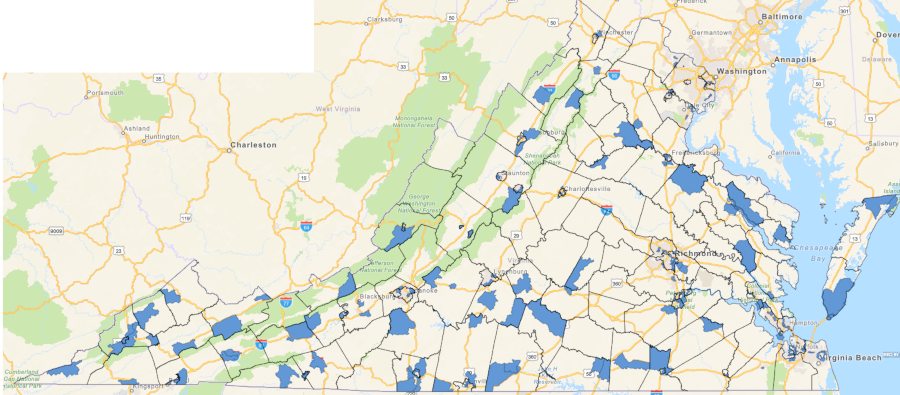
212 Qualified Opportunity Zones were designated in 2018
Source: Virginia Department of Housing and Community Development
In 2019, Fortune magazine included 21 Virginia-based companies in its Fortune500 list that are based on total revenue. Of the companies, 11 were in Northern Virginia, three were in Hampton Roads, and 7 were in or near Richmond.6
No. 40: Freddie Mac, McLean
No. 92: General Dynamics, Falls Church
No. 98: Capital One Financial, McLean
No, 108: Northrop Grumman, Falls Church
No. 122: DXC Technology, Tysons
No. 135: Dollar Tree, Chesapeake
No. 162: Altria Group, Henrico County
No. 174: CarMax, Henrico County
No. 176: Performance Food Group, Richmond
No. 238: Dominion Energy, Richmond
No. 277: Norfolk Southern, Norfolk
No. 296: AES, Arlington
No. 311: Leidos Holdings, Reston
No. 317: Owens & Minor, Mechanicsville
No. 345: Hilton Worldwide Holdings, McLean
No. 360: Genworth Financial, Henrico County
No. 371: Huntington Ingalls Industries, Newport News
No. 424: NVR, Reston
No. 441: Markel, Henrico County
No. 464: Beacon Roofing Supply, Herndon
No. 475: Booz Allen Hamilton, McLean
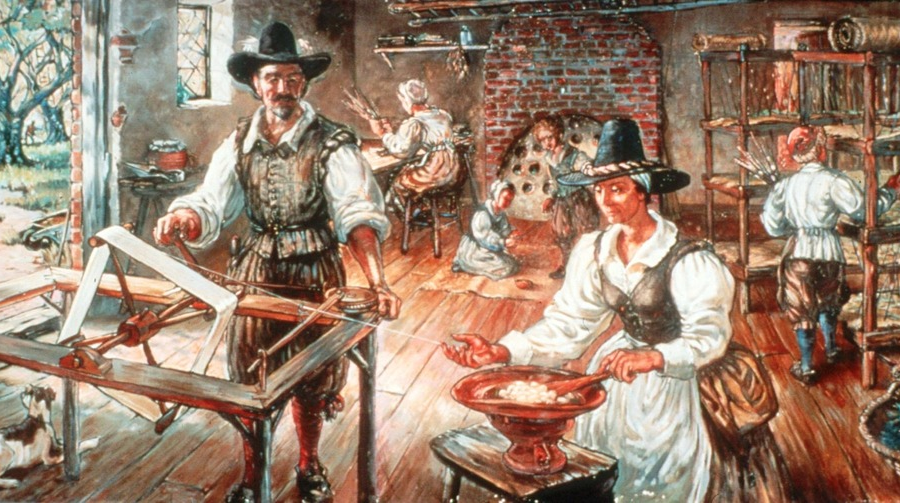
silk production was one of the first industries intiated by the Virginia Company at Jamestown
Source: National Park Service, Silk Culture (painting by Sidney E. King)
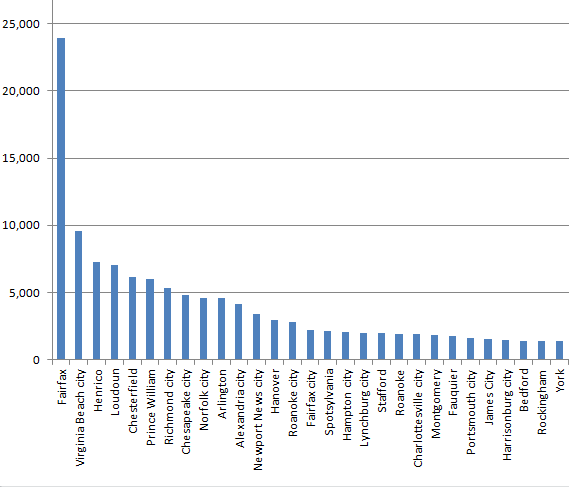
number of business firms in top Virginia counties, 2008
Source: Bureau of Census, Statistics of U.S. Businesses (SUSB) State by county, totals (see spreadsheet)
Links
References
1. "093-0165 Flint Run Archaeological District (Thunderbird Archaeological District)," Virginia Department of Historic Resources, 1975, https://www.dhr.virginia.gov/historic-registers/093-0165/; "Front Royal's Thunderbird District: Silhouettes of the Distant Past," Mountain Courier, May 2, 2023, https://www.themountaincourier.com/articles/featured-stories/front-royals-thunderbird-district-silhouettes-of-the-distant-past/ (last checked April 21, 2025)
2. "Management and Accountability of the Virginia Economic Development Partnership," Joint Legislative Audit and Review Commission, November 2016, http://jlarc.virginia.gov/vedp-2016.asp (last checked May 17, 2019)
3. "2019 Prosperity Cup," Site Selection, May 2019, https://siteselection.com/issues/2019/may/2019-prosperity-cup.cfm; James A. Bacon, "VEDP Snags Recognition as Best Economic Development Organization in Nation," Bacon's Rebellion blog, May 17, 2019, https://www.baconsrebellion.com/wp/vedp-snags-recognition-as-best-economic-development-organization-in-nation/ (last checked May 17, 2019)
4. "Governor Warner Announces Grants to Virginia Manufacturing Partnership," August 15, 2002 news release from Governor Mark Warner, www.governor.state.va.us/Press_Policy/Releases/Aug2002/0815c.htm"www.governor.state.va.us/Press_Policy/Releases/Aug2002/0815c.htm (last checked August 24, 2002)
5. "Opportunity Zones," Virginia Department of Housing and Community Development, http://www.dhcd.virginia.gov/index.php/component/content/article/346.html (last checked June 1, 2018)
6. "One addition, one departure among state firms on Fortune 500," Virginia Business, May 16, 2019, http://www.virginiabusiness.com/news/article/333878 (last checked May 17, 2019)
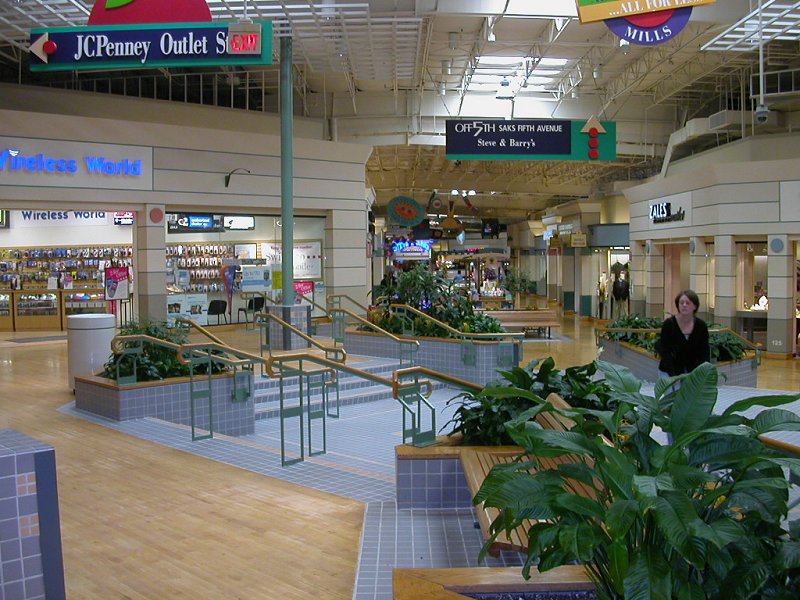
inside Potomac Mills
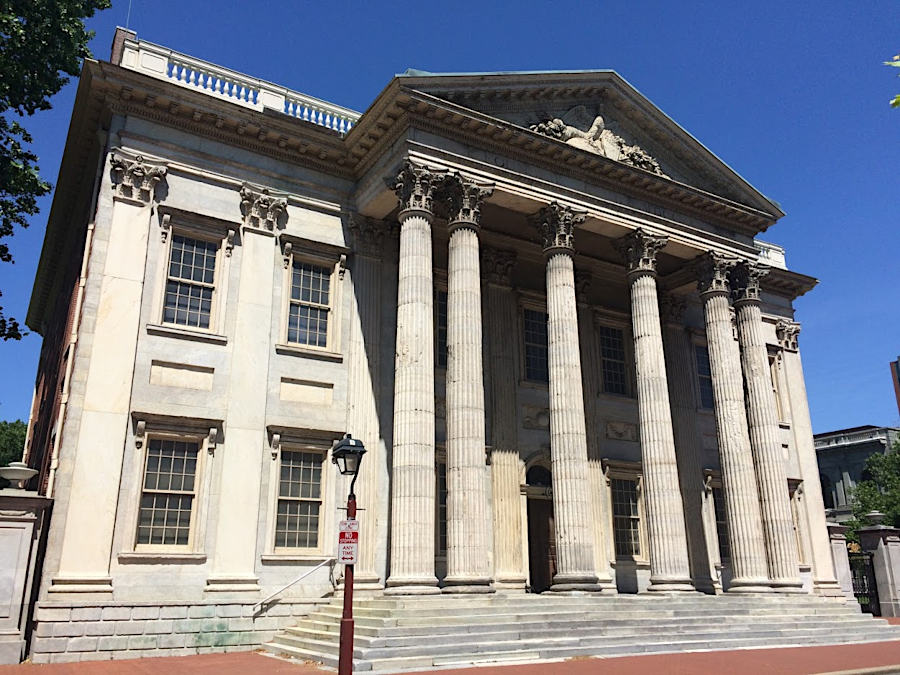
First National Bank in Philadelphia
Virginia Agriculture
Virginia Places












